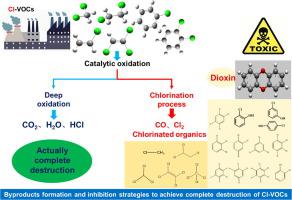Chemical Engineering Journal ( IF 13.3 ) Pub Date : 2020-08-05 , DOI: 10.1016/j.cej.2020.126534 Fawei Lin , Zhiman Zhang , Na Li , BeiBei Yan , Chi He , Zhengping Hao , Guanyi Chen

|
In catalytic oxidation of Cl-VOCs, H2O, CO2, and HCl are anticipated final products, while Cl2 with strong oxidability, CO and organics without complete mineralization are considered as byproducts. The particularity of Cl substitution in Cl-VOCs further brings higher possibility in byproducts formation with higher toxicity. Furthermore, polychlorinated byproducts as predominant precursors for PCDDs and PCDFs are commonly detected, which becomes the biggest potential risk. This review systematically summarizes multiple byproducts distribution in effluent gas and surficial accumulated compounds. The migration pathways of Cl species during catalytic oxidation include HCl desorption assisted by Brønsted acidic sites, Cl2 formation via Deacon reaction, chlorination into organic byproducts, and deposition on catalyst surface. Various strategies for inhibiting byproducts formation are explored based on the critical factors for byproducts formation with target to provide guidance to the development of catalysts for Cl-VOC efficient and complete elimination. Rapid transformation of intermediates without participating chlorination process is the crucial strategy. Improving further oxidation with rational redox property and preventing chlorination with suitable acidity and specific structures are two directions for inhibit byproducts formation. However, it is still challenging to reveal the migration and evolution routes of Cl species and rational design of catalysts to achieve actually complete elimination of Cl-VOCs with no secondary pollution.
中文翻译:

如何完全消除Cl-VOCs:催化氧化过程中副产物形成和抑制策略的重要综述
在Cl-VOC的催化氧化中,H 2 O,CO 2和HCl有望成为最终产物,而具有强氧化性的Cl 2,未完全矿化的CO和有机物被视为副产物。Cl-VOCs中Cl取代的特殊性进一步带来了形成具有更高毒性的副产物的可能性。此外,通常检测到多氯代副产物作为PCDD和PCDF的主要前体,这成为最大的潜在风险。这篇综述系统地总结了多种副产物在废气和表面累积化合物中的分布。Cl物种在催化氧化过程中的迁移途径包括在Brønsted酸性位点辅助下的HCl解吸,Cl 2通过迪肯反应形成,氯化成有机副产物,并沉积在催化剂表面。基于副产物形成的关键因素,探索了多种抑制副产物形成的策略,目的是为开发有效,完全消除Cl-VOC的催化剂提供指导。没有参与氯化过程的中间体快速转化是关键策略。具有合理的氧化还原特性的进一步的氧化作用以及具有适当酸度和特定结构的氯化作用的抑制是抑制副产物形成的两个方向。然而,揭示Cl物种的迁移和演化途径以及合理设计催化剂以实现实际上完全消除Cl-VOC而没有二次污染仍然是一项挑战。


















































 京公网安备 11010802027423号
京公网安备 11010802027423号